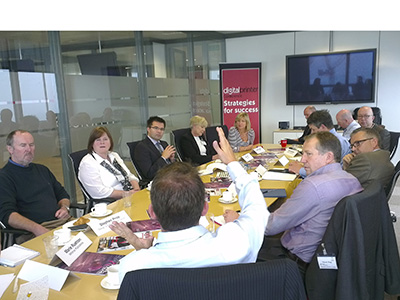Latest in Digital Printer’s Strategies for Success events was a round table discussion entitled ‘Beyond Printing.’ Sean Smyth reports on its discussions.
The view from Ricoh’s site on the 32nd floor of Canary Wharf is spectacular, with the Thames circling the O2 Arena. So too was the discussion at the round table organised by Digital Printer to explore applications Beyond Printing. We were joined by ten UK printers and marketeers, with varying skills and experience in looking beyond print.
They included David Beardsley of Eight Days Per Week, a purely digital printer and Vince Hogg of En-Route Design and Print, with 31 years in print who now uses a B3 Heidelberg with Anicolor to compete with digital providers. Piers Miles of Drayton Print admitted to ‘being excited about cross-media, but also apprehensive,’ identifying cross-media as a good fit with promotional merchandise and events.
Joy Lunn from Telford based Taws Printers has spearheaded the rebranding of Taws as a marketing solutions provider, involving new people and new skills. She commented: ‘Other print companies have followed this route but many fail because they do not have the real skills and credibility.’ Taws employed experienced marketers to put the right people in place, helping it to be seen as a serious consultancy, which takes pressure off price.
Andy Cumming of Disc to Print, a design based communication company using B3 print, emphasised the need to: ‘Get in early and provide the customer with an effective solution,’ saying ‘doing nothing is effectively throwing in the towel for too many print companies.’
Barry Cool from Propeller Design Print provided the perspective of a litho, digital and large format printer with a studio. This company found that changing its approach from selling its production services to selling ‘what we can create’ was a better alternative. He said that many customers do not know what is available, so the role of a printer is to listen to what customers are trying to achieve.
The industry is separating into two strands he feels, one price-driven and the other looking at added value opportunities, a range of services to provide solutions to customers. While this may result in print volume falling there are good
margins available.
Also attending was Karen Brown from Letterworks, a company has undergone several reinventions, from repro and artwork, then bureau services, into print with a Heidelberg DI press and now moving from Xerox to Heidelberg/Ricoh digital kit. She sees digital as a ‘magic word’ that opens doors.
We were also joined by Jacky Morgan from Shire Marketing. She has strong views on how printers should change to work with the new cohort marketing professionals who will ultimately decide the future shape of the print and communication industry. She is convinced it is no longer enough to be ‘just a printer.’ As the buyer profile is changing, so print suppliers need to change with them.
Addressing social media
Hot topics are cross-media, or multi-channel communication. The difficulty was deciding what it is, and why a print company should be part of the offering. There might be web design, e-mail campaigns, personalised URLs, SMS texting and links to Facebook, Twitter or LinkedIn. Understanding how these work is difficult (actually impossible as they are dynamic and fast-changing) but the good news is that no one else really understands how to use the technology ‘correctly,’ so the print community still has an opportunity.
There is no right or wrong way, and if you don’t have the skills it is easy to partner with someone who does. Barry Cool of Propeller attends a monthly technology forum of software and App developers, held locally and uses it to develop a relationship with new media providers.
If you don’t have the skills, partner with someone that does, many of these are freelance and there is little risk for a short term contract. Have them as part of the team, although you need to manage the relationship with customers.
The key is to get into conversation with a marketer early in the genesis of a project, and participate in the development, suggesting ways that print can add value. With on-line campaigns email response can be easily measured with the number of read emails monitored and the proportion of opt outs determined. Adding a physical print item can help push recipients into taking action, always a good thing for the marketer. Remember the response rate is not the critical measure, it is the monetary return.The feedback from our attendees was that the approach opens more doors, and in many cases this leads to printing volume. While this takes time to develop the relationship, using web to print is useful to reduce sales and administration overload for standard products. The message is use the sales resource for high added-value opportunities rather than just order taking.
Solution providers will win out
The key message from the round table is that there are opportunities for solution providers. It is likely that this will be outside the current range of skills in a traditional or digital print provider, but many customers do not have enough time to do all the work in developing a communication campaign themselves either. This means there are opportunities for printers to help manage the process.
I am not sure who said it but the takeaway message is apposite: ‘Be creative because this is a brilliant opportunity for printers, you need to be aware of.’





